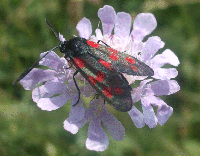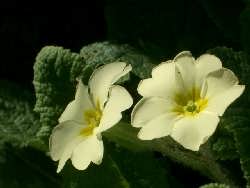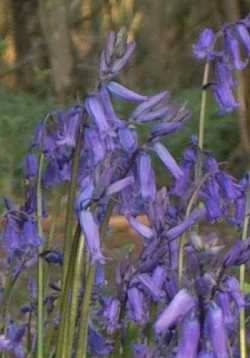When to Watch Wildlife | J | F | M | A | M | J | J | A | S | O | N | D | Search |
Current wildlife highlights | ||
| What's new on this site | ||
| Wildlife calendar | ||
|
Plants and Animals | ||
| Habitats | ||
| Wildlife sites | ||
| WWW links | ||
|
Guide Books | ||
| ||
© PMcS 2006 |
Woodland |
Woodland is probably the most loved of our wildlife habitats. It can be mysterious, uplifting and is often ancient. In Britain many "natural" woodlands are dominated by oak, although large tracts were replanted in the last century with conifers for timber.
primrose The structure of our oak woodlands is actually the product of human management, but these habitats still support a myriad of native species. It is hard not to be wowed by carpets of bluebells in May, with their overpowering scent, but woodlands have so much more to offer! It is probably the case, but no one really knows, that most of this country was woodland following the thaw after the last Ice Age. However along came man and fashioned the landscape through cutting and burning and opened up vast tracts of land. In Britain woodland can grow even to the tops most of our mountains. Only in some areas of Scotland are there woodlands considered to be natural and these are dominated by Scots Pine. Woodland has the special feature that in spring it is quite open as the leaves are yet to appear. However once early summer starts the canopy closes over and the ground is heavily shaded until the leaves fall in Autumn. This annual cycle determines which species are able to thrive. These are plants that are able to put on rapid growth early on when there is enough light for the leaves to create food (via photosynthesis) and can tolerate partial or total shade. Plants with bulbs (e.g. bluebell which favours drier areas, ramson which favours wetter areas) are at an advantage, as in spring the leaves only need to expand from small buds, rather than the plants having to actually grow new leaves. Some other plants have corms or bulbous roots where energy is stored ready for the race each spring. bluebell Other woodland species include the early showers such as lesser celandine, townhall clock, wood violets and early purple orchid. Later on primroses, wood anemone and wood sorrel also come into flower. However numbers of all these species declines if the canopy is not occasionally opened up by active management. Either way all above ground vegetation of these ground species quickly dies back in summer having flowered and set seed. Some other specialities to look out for include herb paris, the graceful wood spurge and the rather ghostly toothwort. All these species mentioned are indicators of long established woodland as they spread so slowly. Woodland that holds significant numbers of these species is likely to be termed "ancient", which is defined as woodland that existed before 1600. Traditional management involves the repeated cutting of the understory hazel almost down to the ground on a 6 to 25 year cycle. This produces branches used for charcoal and many implements. The oak trees that are left to grow (to form "standards") above the coppice. Oak trees are often joined by other species such as ash and hornbeam (especially in the south east of England), and sometimes small-leaved lime. These were cut down for sizable timber and sometimes replanted on an average of 100 year cycle. Although oak is by far the most common large tree in most ancient woodlands today, it thought that small-leaved lime, for instance, may have been more dominant in the past (for example soon after the last ice age). Some oak or ash trees on the edges of woodlands may have been managed as pollards over many centuries. This is where the branches are cut above the height of grazing animals and used for fodder. These grand old trees were are often used as boundaries markers. Many woodlands have emerged from abandoned fields or former "coppice with standard" management (described above). In these site tall oaks or introduced species such as sycamore may dominate. If left untidied the dead wood in such sites can provide a rare and precious habitat for insects, which in turn are fed on by birds. Woodlands are of course home to many other species such as deer species and badgers. The former browse the trees and often cause consider damage. The presence of badgers, which are nocturnal, can be spotted by the presence of large sets and tracks which are used each night. Other mammals include dormice, the wood mouse, bat species, and the red squirrel (which is native) and grey squirrel (an American import) . Some birds are restricted to woodlands and as they only sing in spring or early summer can be hard to spot at other times. Also some bird species are summer migrants. Our natives species include greater and lesser spotted woodpecker, nuthatch, tree creeper, coal tit, willow tit, bluetit, great tit, gold crest, hawfinch, tawny owl and the ubiquitous wren. Summer sees the influx of migrants such as redstart, turtle dove, the willow and garden warblers, blackcap and chiff chaff. Most anticipated of all is the nightingale with its famous song so noticeable during the darkness of night. The nightingale requires dense, mature coppiced hazel to breed in. The important of woodland are insects are often those that favour open, sheltered rides where the sun can reach the ground all year round and plants such a dogs violet and devil's bit scabious thrive. The now rare Pearl-bordered fritillary lays its eggs on violets found in clearings and along paths. Autumn is a special season as the woodland trees prepare for the cold weather when water supplies may be hard to access in frozen ground. Leaves are sapped of their cell contents as as the green chlorophyll is removed the beautiful oranges, reds and brown appear in a spectacular array of colours. Autumn woodlands are particularly rich in the fruiting bodies of fungi. Wood pasture is a special sort of woodland habitat which is characterised by open ground and scattered mature trees maintained by grazing. This is often derived from areas that were formally royal hunting forests where deer was favoured, often over the local people! The New Forest in Hampshire is an example. In some areas, such as the Chilterns, the forest is dominated by beech with very little understory. However the autumn colours are truly spectacular on a cold October day. Where woodland was felled in and converted into arable, but the soil was poor, heathland has often developed once the arable growing was abandoned. This supports heather species, bracken, gorse and silver birch.
|
|
All images and text are copyright PMcS 2006


